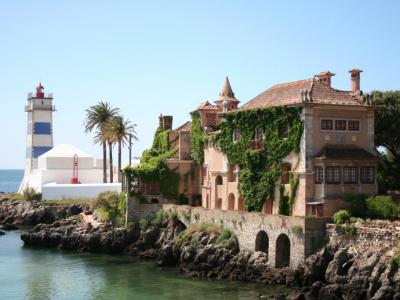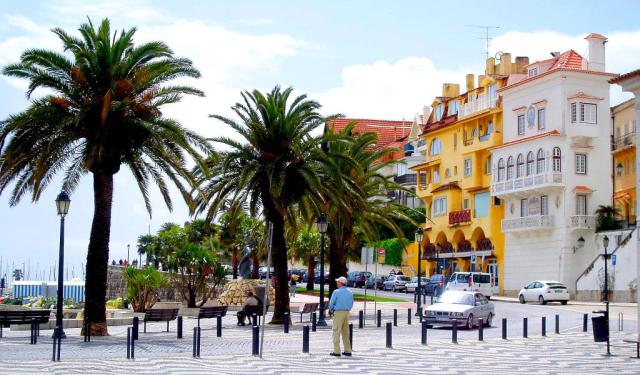
Casa de Santa Maria (House of Saint Mary), Cascais
The House of Saint Mary, once a lavish private residence, now stands as a captivating museum in Cascais. This historic mansion, acquired by the Cascais Municipality in October 2004, seamlessly blends various architectural styles and cultural influences, making it a fascinating destination for both art and history enthusiasts.
In the late 19th century, an aristocrat named Jorge O'Neil, known for his extensive business connections, acquired land near the Santa Marta area of Cascais. His visionary endeavors led to the creation of two significant landmarks in the region: the Condes de Castro Guimarães Museum and the Casa de Santa Maria. The latter was commissioned as a special wedding gift for his daughter and was built in 1902 under the skilled guidance of architect Raul Lino.
Raul Lino, who embarked on his architectural career in Cascais, received a unique directive for the Casa de Santa Maria: to design the house exclusively using materials sourced within Portugal. This distinct challenge led to a design heavily influenced by the Moorish architectural style, with horseshoe arches adorning the central rooms, serving as a testament to the enduring legacy of Moorish craftsmanship in Portugal.
Around 1914, the property changed hands and was acquired by engineer José Lino Júnior, the elder brother of Raul Lino. José Lino, an avid collector and art connoisseur, made notable additions to the house. From an old chapel in Frielas, he acquired a set of 17th-century Azulejo tiles and a wooden, oil-painted ceiling attributed to António de Oliveira Bernardes. The Casa de Santa Maria continued to evolve, gaining prominence as a gathering place for illustrious visitors, including royalty such as Charlotte, Grand Duchess of Luxembourg, King Umberto II of Italy, and the Duke and Duchess of Windsor. Notably, former U.S. President Richard Nixon also graced this exquisite residence with his presence.
Today, the museum boasts a remarkable collection of tiles and paintings, predominantly hailing from the Portuguese Baroque period. The ground floor of the mansion is adorned with polychrome blue and yellow painted tiles originally from the Marvila Convent in Lisbon. Ascend to the first floor, and you'll discover the Chapel adorned with tiled narrative scenes from the life of the Virgin Mary, crafted in Talavera, Spain, during the late 16th century. The floral motifs on the ceiling are the artistic handiwork of Raul Lino himself. Adjacent to the chapel is the Great Hall, featuring a painted ceiling and walls lined with exquisite tiles. The basement adds a touch of avant-garde charm with painted tiles from around 1920, also designed by the talented architect.
In the late 19th century, an aristocrat named Jorge O'Neil, known for his extensive business connections, acquired land near the Santa Marta area of Cascais. His visionary endeavors led to the creation of two significant landmarks in the region: the Condes de Castro Guimarães Museum and the Casa de Santa Maria. The latter was commissioned as a special wedding gift for his daughter and was built in 1902 under the skilled guidance of architect Raul Lino.
Raul Lino, who embarked on his architectural career in Cascais, received a unique directive for the Casa de Santa Maria: to design the house exclusively using materials sourced within Portugal. This distinct challenge led to a design heavily influenced by the Moorish architectural style, with horseshoe arches adorning the central rooms, serving as a testament to the enduring legacy of Moorish craftsmanship in Portugal.
Around 1914, the property changed hands and was acquired by engineer José Lino Júnior, the elder brother of Raul Lino. José Lino, an avid collector and art connoisseur, made notable additions to the house. From an old chapel in Frielas, he acquired a set of 17th-century Azulejo tiles and a wooden, oil-painted ceiling attributed to António de Oliveira Bernardes. The Casa de Santa Maria continued to evolve, gaining prominence as a gathering place for illustrious visitors, including royalty such as Charlotte, Grand Duchess of Luxembourg, King Umberto II of Italy, and the Duke and Duchess of Windsor. Notably, former U.S. President Richard Nixon also graced this exquisite residence with his presence.
Today, the museum boasts a remarkable collection of tiles and paintings, predominantly hailing from the Portuguese Baroque period. The ground floor of the mansion is adorned with polychrome blue and yellow painted tiles originally from the Marvila Convent in Lisbon. Ascend to the first floor, and you'll discover the Chapel adorned with tiled narrative scenes from the life of the Virgin Mary, crafted in Talavera, Spain, during the late 16th century. The floral motifs on the ceiling are the artistic handiwork of Raul Lino himself. Adjacent to the chapel is the Great Hall, featuring a painted ceiling and walls lined with exquisite tiles. The basement adds a touch of avant-garde charm with painted tiles from around 1920, also designed by the talented architect.
Want to visit this sight? Check out these Self-Guided Walking Tours in Cascais. Alternatively, you can download the mobile app "GPSmyCity: Walks in 1K+ Cities" from Apple App Store or Google Play Store. The app turns your mobile device to a personal tour guide and it works offline, so no data plan is needed when traveling abroad.
Casa de Santa Maria (House of Saint Mary) on Map
Sight Name: Casa de Santa Maria (House of Saint Mary)
Sight Location: Cascais, Portugal (See walking tours in Cascais)
Sight Type: Museum/Gallery
Guide(s) Containing This Sight:
Sight Location: Cascais, Portugal (See walking tours in Cascais)
Sight Type: Museum/Gallery
Guide(s) Containing This Sight:
Walking Tours in Cascais, Portugal
Create Your Own Walk in Cascais
Creating your own self-guided walk in Cascais is easy and fun. Choose the city attractions that you want to see and a walk route map will be created just for you. You can even set your hotel as the start point of the walk.
Cascais Introduction Walking Tour
A charming seaside town some 30 minutes' drive away from the capital of Portugal, Cascais, holds a unique place in the country's history and culture. It started life as a humble fishing village, with the Romans, Visigoths, and Muslims leaving their mark on the area. Records dating back to Roman times suggest that it served as a stopover point for travelers along the coastline.
The... view more
Tour Duration: 2 Hour(s)
Travel Distance: 2.4 Km or 1.5 Miles
The... view more
Tour Duration: 2 Hour(s)
Travel Distance: 2.4 Km or 1.5 Miles

